[ Back ] [ Next ]
Aug 6, 2005 – Kalocsa
Breakfast came early in Kalocsa, since the
buses left around 8:00 for the excursion. This included a folklore museum, full
of
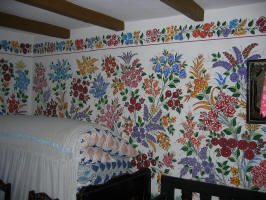 crafts, especially embroidery.
The house itself was painted with the floral motifs traditional to this region.
T
crafts, especially embroidery.
The house itself was painted with the floral motifs traditional to this region.
T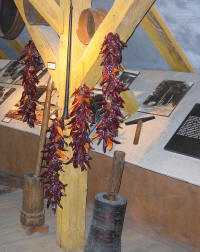 hen
we went to the Paprika museum, depicting the process of growing, drying, and
grinding paprika, currently as well as
historically. Our next stop was the Church in the center of the square. The
square had a statue commemorating heroes of World War I,
which delighted me – not only did it have a soldier, but it also had an old man
and a mother with a small child. Pretty moving, when you stop to think about it.
In the Church, we were treated to a lovely organ concert. We were impressed that
such a small town had such a magnificent organ. When we boarded the buses, two
wives discovered missing husbands. One, Peter, is an avid bird-watcher. We all
burst out laughing as Patricia kept looking up in trees as she tried to find
him. The men
hen
we went to the Paprika museum, depicting the process of growing, drying, and
grinding paprika, currently as well as
historically. Our next stop was the Church in the center of the square. The
square had a statue commemorating heroes of World War I,
which delighted me – not only did it have a soldier, but it also had an old man
and a mother with a small child. Pretty moving, when you stop to think about it.
In the Church, we were treated to a lovely organ concert. We were impressed that
such a small town had such a magnificent organ. When we boarded the buses, two
wives discovered missing husbands. One, Peter, is an avid bird-watcher. We all
burst out laughing as Patricia kept looking up in trees as she tried to find
him. The men
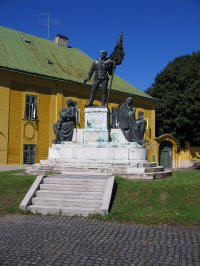 had seen the first buses leaving and were running frantically to
catch them, not noticing that one bus was still waiting. Our tour guide, Marian,
chased after them. Together at last, we drove about half hour into the country –
lots of open fields including many growing paprika peppers. Well ensconced in the Puszta, we were treated to brandy, pogácsa, and a great exhibition of horsemanship. In addition, one of the riders
played the tárogató, a clarinet-like instrument of which there are supposedly
only about 80 left in the world. He was an excellent musician (also playing the
zither), and it was a treat listening to him.
had seen the first buses leaving and were running frantically to
catch them, not noticing that one bus was still waiting. Our tour guide, Marian,
chased after them. Together at last, we drove about half hour into the country –
lots of open fields including many growing paprika peppers. Well ensconced in the Puszta, we were treated to brandy, pogácsa, and a great exhibition of horsemanship. In addition, one of the riders
played the tárogató, a clarinet-like instrument of which there are supposedly
only about 80 left in the world. He was an excellent musician (also playing the
zither), and it was a treat listening to him.
We went back to the boat which departed for
points south, had lunch and actually had some free time, during which Zsuzsa and
I worked on the jigsaw puzzle which had been set out to tempt us, and waved to
the bicyclists and pedestrians on the riverfront at Mohács, where we stopped for
border control for seemingly hours. The afternoon lectures were Susan Suleiman’s
“Irony and Melancholy: Looking back at the Hapsburg Empire from the 1930s and
1940s” and Michael Murrin’s “Attila at home in Hungary”. Both were interesting
if not particularly memorable. After the “Pirates’ Dinner” we were ready to drop
into bed again.
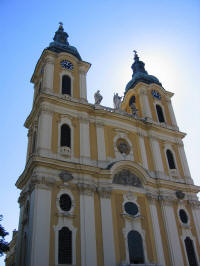
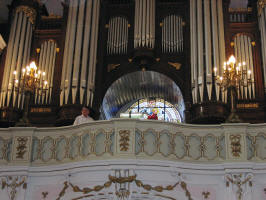
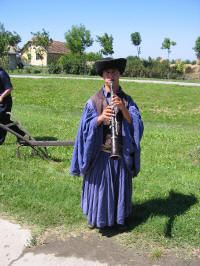
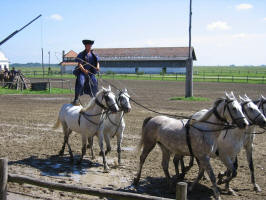
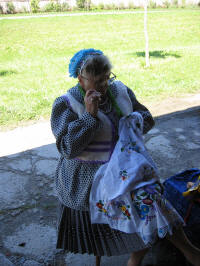
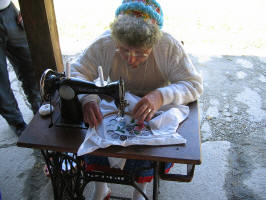
 had seen the first buses leaving and were running frantically to
catch them, not noticing that one bus was still waiting. Our tour guide, Marian,
chased after them. Together at last, we drove about half hour into the country –
lots of open fields including many growing paprika peppers. Well ensconced in the Puszta, we were treated to brandy, pogácsa, and a great exhibition of horsemanship. In addition, one of the riders
played the tárogató, a clarinet-like instrument of which there are supposedly
only about 80 left in the world. He was an excellent musician (also playing the
zither), and it was a treat listening to him.
had seen the first buses leaving and were running frantically to
catch them, not noticing that one bus was still waiting. Our tour guide, Marian,
chased after them. Together at last, we drove about half hour into the country –
lots of open fields including many growing paprika peppers. Well ensconced in the Puszta, we were treated to brandy, pogácsa, and a great exhibition of horsemanship. In addition, one of the riders
played the tárogató, a clarinet-like instrument of which there are supposedly
only about 80 left in the world. He was an excellent musician (also playing the
zither), and it was a treat listening to him. 

